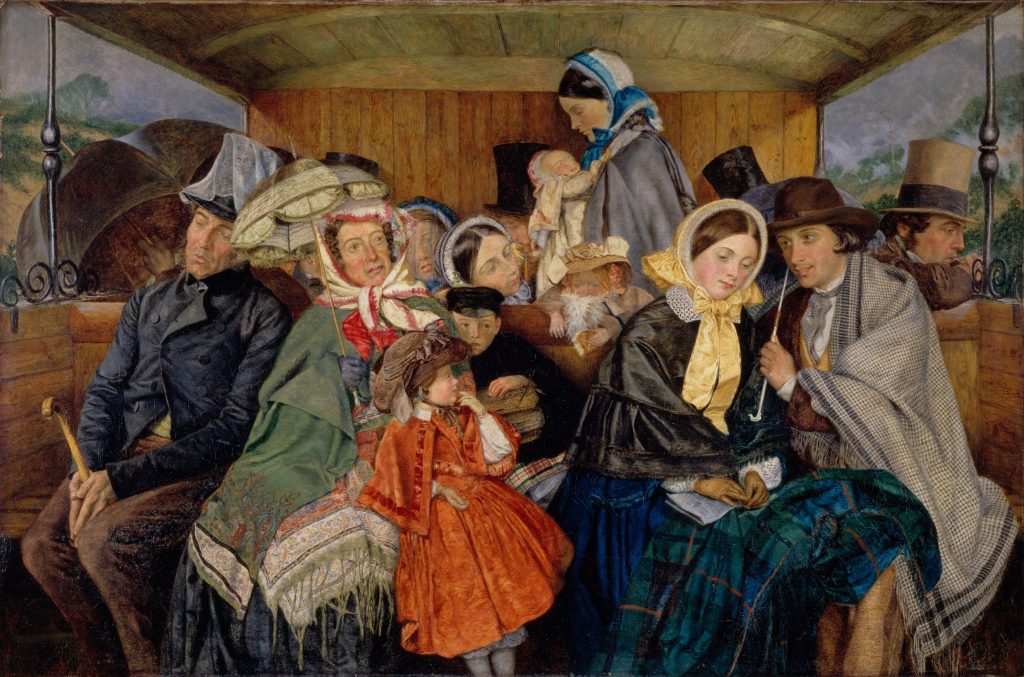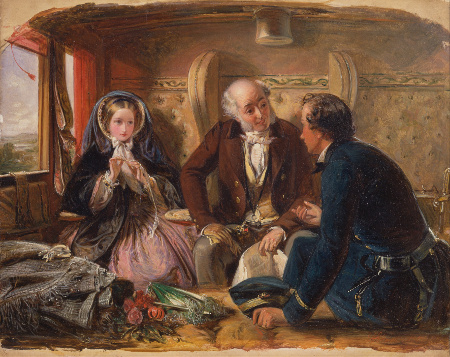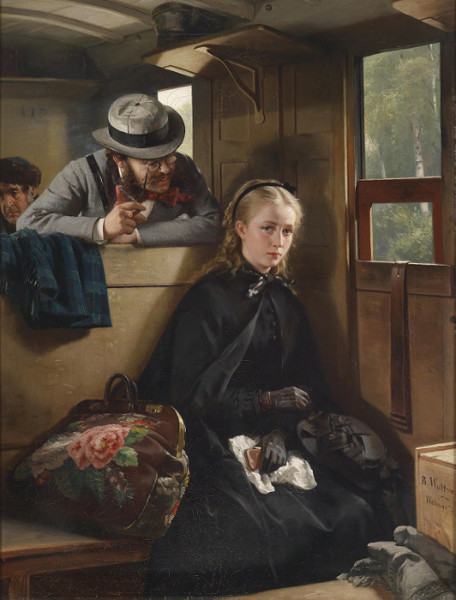1879: Pictorial Sources: The Train
We’ve provided stats for trains, for locomotives and passenger cars and wagon-lits, and we’ve talked a little bit about the experience of being a passenger. Let’s look a bit closer at what people thought of trains in the era, shall we?
While there was a fascination with trains in the late 1800s, only the engineering boffins were really that into the technology itself. A larger percentage saw the railways as investment opportunities, leading to the railway bubble and quite a few of them losing everything to railroads that were never built. As usual, only a very few, who got in early and had the financial clout to muscle through, became the railway barons of the later years. We’ll talk more about them some other time.
 Most people were worried about the impact of the railways, and most especially upon society. How was one supposed to maintain propriety in the cramped confines of a railway coach, packed in with a lot of total strangers? Here’s “To Brighton and Back for 3S 6D” by Charles Rossiter, from early in the period, when railcars were still open at the sides and built more like horsecarts. We’ve got people huddled up against each other, or resolutely staring off to the side like in a modern subway car, trying to deal with being too close for comfort. Look at the woman on the right, so very uncertain about all this, and her children, one fascinated by the young couple next to them and the other hiding behind her. The rules hadn’t yet adjusted for this sort of social closeness, this invasion of proximity.
Most people were worried about the impact of the railways, and most especially upon society. How was one supposed to maintain propriety in the cramped confines of a railway coach, packed in with a lot of total strangers? Here’s “To Brighton and Back for 3S 6D” by Charles Rossiter, from early in the period, when railcars were still open at the sides and built more like horsecarts. We’ve got people huddled up against each other, or resolutely staring off to the side like in a modern subway car, trying to deal with being too close for comfort. Look at the woman on the right, so very uncertain about all this, and her children, one fascinated by the young couple next to them and the other hiding behind her. The rules hadn’t yet adjusted for this sort of social closeness, this invasion of proximity.
 Abraham Solomon did a trilogy of meditations on propriety in a railway carriage. Here, in the first of the series, “First Class – The Meeting”, a young lady and her guardian find themselves in a first class cabin with a handsome young man. The guardian interposes himself between the two, maintaining the boundaries. While he seems reasonably taken with the young man, and might be willing to allow some conversation between the two younger folk, propriety will be maintained. Note her posture, leaning back a little, uncertain, as the two men bargain for the right to her attention. Yes, it’s horribly patriarchal, but then society, especially in the upper classes, treated women like second class citizens much more openly at that point.
Abraham Solomon did a trilogy of meditations on propriety in a railway carriage. Here, in the first of the series, “First Class – The Meeting”, a young lady and her guardian find themselves in a first class cabin with a handsome young man. The guardian interposes himself between the two, maintaining the boundaries. While he seems reasonably taken with the young man, and might be willing to allow some conversation between the two younger folk, propriety will be maintained. Note her posture, leaning back a little, uncertain, as the two men bargain for the right to her attention. Yes, it’s horribly patriarchal, but then society, especially in the upper classes, treated women like second class citizens much more openly at that point.
 And here we have the second painting. Oh dear, the guardian has fallen asleep, as tends to happen with older folks in moving vehicles. The young man is pursuing his suit directly with the young woman. There’s jewelry involved. It’s a necklace, though, and not a ring. The likelihood of this ending in tears, well…
And here we have the second painting. Oh dear, the guardian has fallen asleep, as tends to happen with older folks in moving vehicles. The young man is pursuing his suit directly with the young woman. There’s jewelry involved. It’s a necklace, though, and not a ring. The likelihood of this ending in tears, well…
 And here we have the third piece, in which the woman, now older, and with no man with her, but a child, is riding in second class. She’s fallen, in social standing and in virtue, all because she was left alone in a train carriage with a young man. Breaches of propriety were assumed to result in damage, in sin, in disgrace, by the people of the time. The rules were in place for what they considered very good reasons. The railways disregarded the rules, put people in small boxes with strangers, of course bad things were going to happen.
And here we have the third piece, in which the woman, now older, and with no man with her, but a child, is riding in second class. She’s fallen, in social standing and in virtue, all because she was left alone in a train carriage with a young man. Breaches of propriety were assumed to result in damage, in sin, in disgrace, by the people of the time. The rules were in place for what they considered very good reasons. The railways disregarded the rules, put people in small boxes with strangers, of course bad things were going to happen.
 Without a guardian, the young woman traveling alone was vulnerable to all sorts of importunements. Here, in Berthold Woltze’s “The Irritating Gentleman”, we have a fellow who just won’t take no for an answer. Look familiar? Oh yes, we still have that sort of person today, and “gentleman” is certainly not the right word for them, but then Victorians didn’t have the word “douchebro”. If he leans any closer, she’s likely to stab him with a hatpin or raise a cry of “Baker!” or both, and she really ought to. She might not, though, as society then (as now) may side with the man in the situation, and blame the woman for bringing it upon herself. She is after all violating the rules of propriety, just by traveling alone.
Without a guardian, the young woman traveling alone was vulnerable to all sorts of importunements. Here, in Berthold Woltze’s “The Irritating Gentleman”, we have a fellow who just won’t take no for an answer. Look familiar? Oh yes, we still have that sort of person today, and “gentleman” is certainly not the right word for them, but then Victorians didn’t have the word “douchebro”. If he leans any closer, she’s likely to stab him with a hatpin or raise a cry of “Baker!” or both, and she really ought to. She might not, though, as society then (as now) may side with the man in the situation, and blame the woman for bringing it upon herself. She is after all violating the rules of propriety, just by traveling alone.
The crowds brought together all sorts of people. William Powell Frith’s “Railway Station” speaks for itself, in its wildly assorted crowd. Zoom in on this, we’ve posted it at a large scale so that you can browse through the details. The art dealer who commissioned the work is in the background, talking with the engineer at the locomotive.

When people thought of the technology itself, it was sometimes wistful, and focused on how it affected rural communities. Here, in Edward Lamson Henry’s “Coming Train”, we have a scene familiar to modern eyes, people looking down the track to see where the train might be, wagons waiting to the side for their freight to be loaded, and a crowded platform even this far out from the city.

Trains, while seen as convenient, were nevertheless infamous for their smoke, their noise, the impact they had on the environment. We’ll close out with Claude Monet’s “Gare Saint-Lazare”, with its moody, sombre tones, the clouds of smoke and steam filling the space above the trains all the way to the shed roof, people dwarfed by machinery nearly lost in the haze. Victorians worried about trains. They used them nonetheless, more and more as time went by, but they never quite resolved the social issues, did they? We’ve still got so many of them now.

